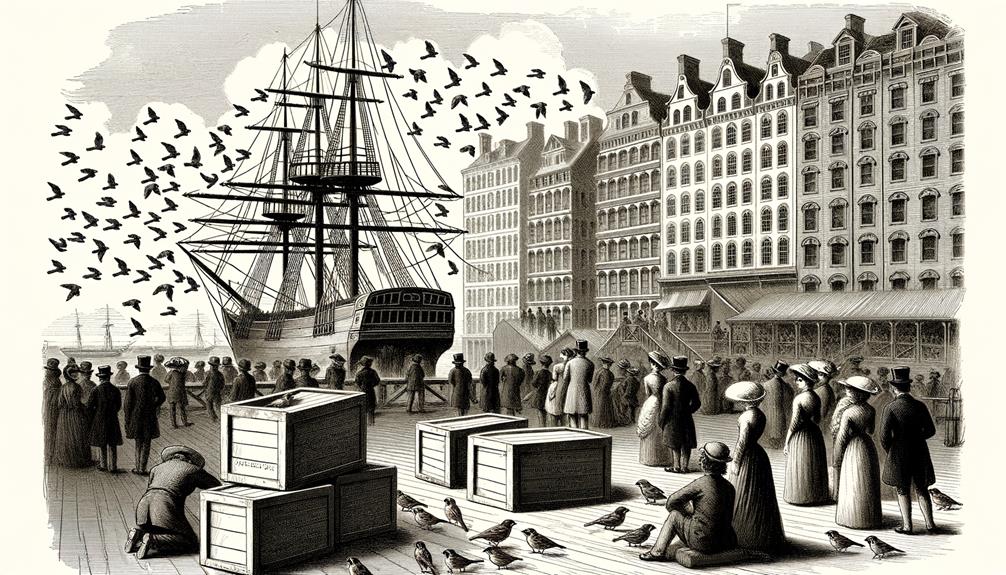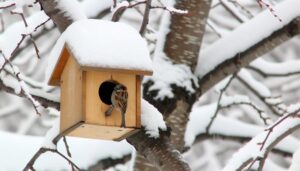Did House Sparrows Get to America: Tracing Their Journey
House Sparrows (Passer domesticus) originated in Europe and were introduced to North America to control insect pests and for nostalgic reasons by European settlers. The first documented release occurred in Brooklyn, New York, in 1851.
Their adaptability to urban environments, dietary flexibility, and high reproductive rates facilitated rapid spread across the continent. Utilizing transportation networks, they established themselves in various habitats, often outcompeting native bird species.
Their presence has significantly impacted local ecosystems. Subsequent population dynamics have been influenced by urbanization, agricultural practices, and climate change.
Further insights into their ecological impact and current trends are available.

Key Takeaways
- House sparrows originated in Europe.
- They were introduced to America for pest control.
- The first release occurred in Brooklyn, New York, in 1851.
- Early adaptations to urban environments aided their spread.
- Transportation networks facilitated their dispersion across America.
Origins in Europe
The house sparrow (Passer domesticus), a species native to Europe, has a long history that dates back to its initial domestication and proliferation in agricultural societies.
Originating in the Middle East, the house sparrow's close association with human settlements facilitated its spread across Europe. This synanthropic bird thrived in environments altered by human activity, particularly in agricultural landscapes where grain and seeds were readily available.
The species' adaptability to diverse climates and habitats contributed to its widespread distribution. Historical records indicate that house sparrows were well-established in urban and rural areas across Europe by the 19th century.
Their robust social structure and reproductive success further secured their dominance in these regions, setting the stage for their eventual introduction to other continents.
Reasons for Introduction
Early European settlers in America introduced house sparrows to the continent as part of efforts to control insect populations and to bring familiar wildlife to their new environment. The primary rationale was their perceived utility in managing agricultural pests, particularly caterpillars and other insects detrimental to crops.
Additionally, settlers sought to replicate the ecological and aesthetic aspects of their homeland, believing that familiar bird species would ease the adaptation to their new surroundings. The introduction was also motivated by a broader trend of acclimatization societies, which aimed to establish European flora and fauna in non-native regions.
This practice reflected a belief in the ecological benefits of such introductions, although the long-term consequences were not fully understood at the time.
The First Release
The initial introduction of house sparrows (Passer domesticus) in America occurred in 1851, when a small number of birds were released in Brooklyn, New York.
This release location was selected with the intention of controlling insect pests that were affecting local trees.
Following their release, the house sparrow population exhibited rapid growth, quickly expanding to surrounding areas.
Initial Introduction Event
In 1851, a small group of house sparrows was released in Brooklyn, New York, marking the initial introduction of this species to North America. This event is a pivotal moment in the ecological history of the continent, as it set the stage for the widespread establishment of house sparrows in the region.
The introduction was motivated by the belief that these birds could help control insect populations and add a familiar touch of European wildlife to American cities. This deliberate release, despite its initial small scale, had significant ecological ramifications, as house sparrows rapidly adapted and proliferated.
Within a few decades, they became one of the most common bird species across urban and rural landscapes in North America.
Release Location Details
Brooklyn, New York, served as the initial release site for house sparrows in North America, chosen for its urban environment and potential to support the birds' adaptation and proliferation. This decision was influenced by several key factors:
- Dense Human Population: Providing ample food sources and nesting sites.
- Urban Architecture: Offering numerous crevices and ledges suitable for nesting.
- Abundant Resources: Ensuring access to food scraps and grains.
- Mild Climate: Favorable for year-round survival and reproduction.
- Proximity to Transportation Hubs: Facilitating further dispersal.
The selection of this location was strategic, aiming to maximize the chances of successful establishment and rapid population growth in the new environment. This release marked the beginning of the house sparrow's extensive spread across the continent.
Early Population Growth
Following their initial release in Brooklyn, house sparrows exhibited a remarkable ability to quickly establish a stable and expanding population. This early success can be attributed to several factors, including their high reproductive rate and adaptability to diverse urban environments.
House sparrows typically breed multiple times per year, producing large broods that notably bolster population growth. Additionally, their omnivorous diet allows them to exploit various food sources, from seeds to human refuse. The species' social structure, characterized by communal roosting and nesting, further enhances their survival and proliferation.
Consequently, within a few decades, house sparrows had spread across the Northeastern United States, demonstrating an impressive capacity for rapid colonization and population expansion.
Early Adaptations
House sparrows' initial survival in North America rested on their ability to exploit urban environments and human-altered landscapes. Their adaptive strategies facilitated their rapid establishment and proliferation.
Importantly, these birds demonstrated:
- Dietary flexibility: Consuming a wide range of human food waste and agricultural products.
- Nesting versatility: Utilizing buildings, bridges, and other man-made structures for nesting sites.
- Tolerance to human presence: Thriving in close proximity to humans, reducing predation risks.
- Reproductive capacity: Producing multiple broods per year, which accelerated population growth.
- Behavioral plasticity: Adapting to varying climates and environmental conditions across urban and rural settings.
These adaptations were vital for their early success in a novel environment, allowing house sparrows to establish a robust foothold in North America.
Spread Across America
The proliferation of House Sparrows across America can be attributed to their remarkable adaptation to urban environments and the facilitation provided by transportation and trade networks.
These birds have demonstrated an exceptional ability to thrive in densely populated human habitats where food and nesting sites are abundant.
Additionally, the expansion of railroads and increased commercial activity in the 19th and 20th centuries greatly accelerated their geographic spread.
Urban Environment Adaptation
Urbanization has facilitated the rapid spread and adaptation of house sparrows across America, enabling them to thrive in diverse metropolitan landscapes. Their remarkable adaptability to urban environments can be attributed to several key factors:
- Availability of food sources: Abundant waste and bird feeders provide consistent nourishment.
- Nesting opportunities: Buildings and other structures offer numerous nesting sites.
- Reduced predation: Urban areas often have fewer natural predators.
- Climate moderation: Cities tend to have milder microclimates due to the urban heat island effect.
- Human activity: Frequent human presence and activity create less fear of humans and more opportunities for scavenging.
These factors collectively contribute to the successful urban adaptation and proliferation of house sparrows in American cities.
Transportation and Trade
Facilitated by extensive transportation networks and burgeoning trade routes, the distribution of house sparrows across America has been markedly accelerated. The advent of railways, shipping lanes, and highways, coupled with increased human mobility and commerce, has played a pivotal role in their spread. Goods transported between urban centers inadvertently carried these adaptable birds, allowing them to establish new populations rapidly. The correlation between trade hubs and sparrow density underscores the species' reliance on human activity for dissemination.
| Transportation Mode | Impact on Distribution | Examples |
|---|---|---|
| Railways | High | New York to Chicago |
| Shipping Lanes | Moderate | Coastal Cities |
| Highways | Low | Inland Towns |
This interdependence highlights the profound influence of human infrastructure on avian geography.
Urban Habitats
How do House Sparrows adapt so effectively to urban environments? Their remarkable adaptability is a result of several key behavioral and physiological traits that enable them to thrive in cities.
These traits include:
- Dietary Flexibility: House Sparrows consume a wide range of food, from grains to human leftovers.
- Nesting Versatility: They can nest in diverse structures such as buildings, bridges, and streetlights.
- Tolerance to Disturbance: Sparrows are highly tolerant of human activity and noise.
- Reproductive Rate: They breed multiple times per year, ensuring rapid population growth.
- Social Behavior: House Sparrows exhibit strong social structures, which aid in foraging and predator avoidance.
These characteristics collectively contribute to their success in urban settings, where other species may struggle.
Ecological Impact
The ecological impact of House Sparrows in America encompasses both their role in local ecosystems and their interactions with native species. Introduced in the 19th century, these birds have adapted to diverse habitats, often outcompeting native bird species for resources. House Sparrows are known to aggressively compete for nesting sites, displacing native cavity-nesters such as bluebirds and swallows.
Additionally, they contribute to the decline of insects essential for the diet of native birds and affect plant pollination dynamics by feeding on seeds and buds. Their presence has led to changes in the population dynamics of affected species, altering community structures. Studies highlight the importance of monitoring and managing their populations to mitigate negative impacts on native biodiversity.
Current Population Trends
Over recent decades, the population trends of House Sparrows in America have exhibited significant fluctuations, influenced by urbanization, agricultural practices, and climate change. These factors have collectively contributed to both local population increases and declines.
Detailed observations indicate:
- Urbanization: Densely populated urban areas provide ample food sources but limited nesting sites.
- Agricultural Practices: Changes in farming techniques, such as reduced grain spillage, have negatively impacted food availability.
- Climate Change: Altered weather patterns affect breeding cycles and food supply.
- Predation: Increased presence of predators in certain areas contributes to population control.
- Competition: Encroachment from other bird species for food and nesting sites creates survival challenges.
Understanding these dynamics is essential for developing effective conservation strategies.
Conclusion
The introduction of house sparrows to America, initially intended to control insect populations, led to widespread adaptation and proliferation across diverse habitats. From their origins in Europe to occupying urban environments throughout North America, these birds have demonstrated remarkable ecological plasticity.
What unforeseen consequences might arise from such human-mediated species introductions? Current population trends indicate a stable presence, underscoring the need for ongoing research to understand and mitigate potential ecological impacts.






